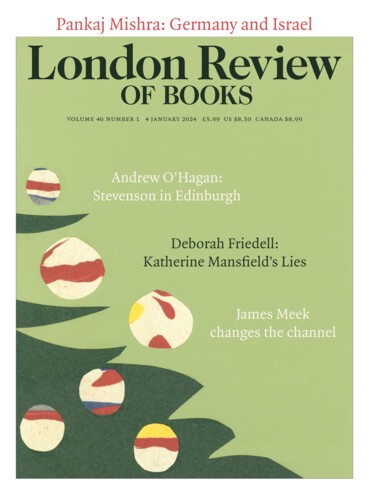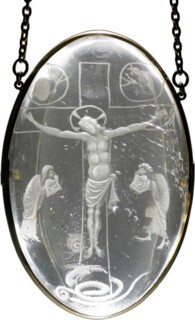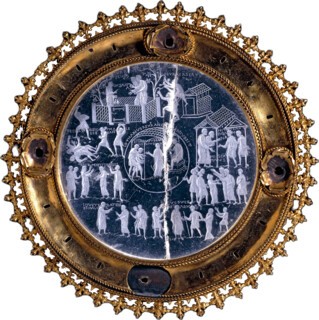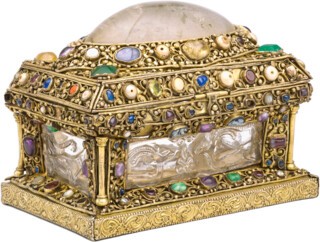In 2005, during preparations for a new underground train line in Cologne, a treasure trove of precious stones was uncovered close to the city’s Gothic cathedral: tiny polished cabochons, diamond-shaped pyramids and thousands of fragments of beautiful unworked shards. Archaeologists were quick to identify this hoard of disjecta membra as the offcuts and unused scraps of a 12th-century workshop specialising in cutting rock crystal, a material which has ranked since our earliest history as among the rarest to be worked by human hands. Writing in the first century ad, Pliny the Elder considered it superior to ivory and gold: ‘Of objects that lie upon the surface of the earth, it is crystals that are most highly esteemed.’
Rock crystal’s status stemmed from its rarity and its extraordinary beauty, made even more glorious through carving and polishing. But above all it was the stone’s unparalleled clarity that provoked wonder in those who beheld it. Up until the Renaissance, when Venetian craftsmen discovered a way to produce colourless glass – which they called cristallo – rock crystal was by some measure the clearest known solid. It was for this reason that Pliny argued it wasn’t like other stones at all but was, in fact, petrified water. He believed that rock crystal could only ‘be found in places where the winter snow freezes with the greatest intensity’; in his case, Alpine riverbeds, the major source of rock crystal in Europe at the time. From this idea of the stone’s cold, magical transformation, it was given the name krystallos (Greek for ‘ice’). In fact it is a variety of quartz, formed from cooling magma in the earth’s crust.
Voyage dans le cristal at the Musée de Cluny (until 14 January) explores the myriad ways humans have manipulated rock crystal. The exhibition’s title derives from George Sand’s novella of 1864, in which two cousins called Alexis and Laura find a way to enter a crystal, discovering a fantastical realm within. Among the first – and earliest – objects in the Cluny’s crystal world is a tiny prehistoric rock crystal arrowhead or spear, discovered in the 19th century at the grotte du Placard in Vilhonneur, and dated to between 21,000 and 16,000 bc. It’s shaped like a bay leaf and is no longer than a matchstick. The rock crystal treasures on display from the ancient Mediterranean include engraved cylindrical seals from Mesopotamia, miniature divine statues from the Hittite empire and carved cats and hippopotamuses from Egypt. Many of these objects share an equivalent scale; their form derives from the shape of naturally occurring crystal shards. But other ancient fragments signal the existence of monumental forms: a curious life-sized crystal hand, perhaps that of a Roman emperor, is remarkable for its verisimilitude.
Rock crystal carvings from the Middle Ages are particularly enchanting. In certain parts of Europe, in workshops patronised by royalty, highly skilled sculptors learned to manipulate the optical properties of the stone for dramatic effect. A bulbous ninth-century cabochon, the size of a large goose egg and known as the Saint-Denis Crystal (from its historical association with the royal abbey), is one of the best examples of this optical playfulness. On its flat side, a scene of the Crucifixion has been engraved, with Christ at the centre, his arms outstretched, and Mary and John the Evangelist below. When turned over and viewed through the thickness of the egg-shaped cabochon, the scene of Christ’s painful sacrifice is magnified. Depending on the light source and your viewpoint, his body contorts this way and that, and Mary and John’s grief seems all the more intense.
More spectacular still is the Lothair Crystal, named after the Frankish king who ordered it, possibly in Reims in the ninth century. It’s an idiosyncratic work, on a par with the best manuscripts of the period – the equivalent, say, of the Utrecht Psalter. Scenes from the story of Susannah and the Elders are painstakingly engraved into the crystal surface in expressive and minute detail, each image topped by a millimetre-sized inscription in Latin to identify the story. Its gilded silver frame dates from the 15th century; unlike many of the earlier carvings in the exhibition, the Lothair Crystal remained in use for the best part of a millennium, perhaps remounted to a precious reliquary or fixed into a royal throne. What exactly it was used for when it was first produced remains unclear.
Reuse is central to the story of rock crystal in the Middle Ages. Europeans desired and sought out carvings from the Islamic world, particularly those produced during the Abbasid and Fatimid caliphates. Islamic rock crystal was sourced not from the European alps but from Madagascar, which goes some way to disproving Pliny’s theory that the stone had an icy origin. Islamic trade networks at the time stretched from China to Africa. A small group of seven pitchers, made around 1000 ad in Cairo, are among the most awe-inspiring works ever created in rock crystal. (Sadly, they are too fragile to have been included in the show, but the catalogue describes them in detail.) Each jug was made from a single large piece of crystal, which was carefully hollowed out and decorated with images of plants and beasts: lions, birds of prey, ibexes. Despite having been made for reigning caliphs, several of these objects later entered church treasuries in Europe, including those of San Marco in Venice and Fermo Cathedral, where they were equally prized for their beauty and the skill of their fashioning. Other smaller, less dramatic items from the Islamic world also made their way to Europe. Finger-sized crystal phials, possibly produced as perfume vessels in the tenth century (and perhaps as a by-product of larger vessels), were transformed after their arrival in Europe into miniature Christian reliquaries. Some still contain wrapped silk relics and the handwritten label describing their saintly contents.
Send Letters To:
The Editor
London Review of Books,
28 Little Russell Street
London, WC1A 2HN
letters@lrb.co.uk
Please include name, address, and a telephone number.




